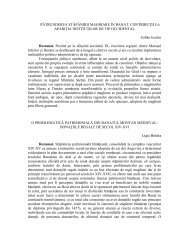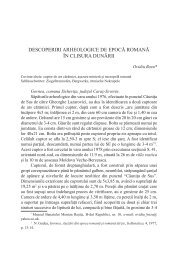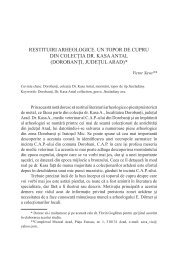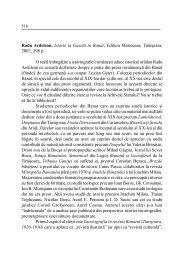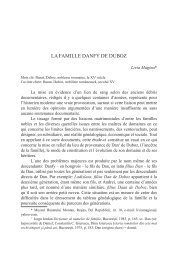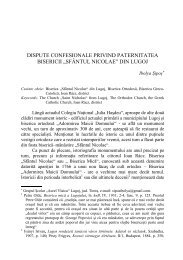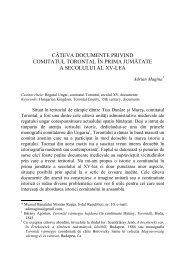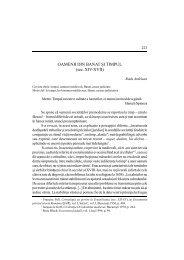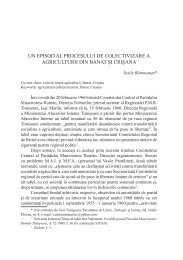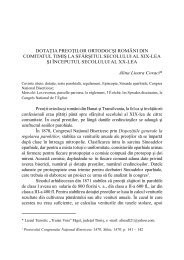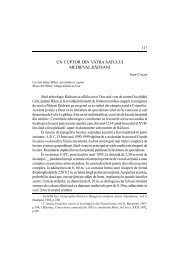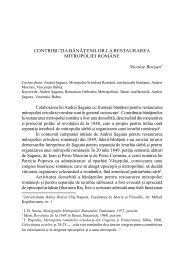Alexandru Simon - Banatica
Alexandru Simon - Banatica
Alexandru Simon - Banatica
Create successful ePaper yourself
Turn your PDF publications into a flip-book with our unique Google optimized e-Paper software.
also auf Kay Mayt bevelh wol unnd statlich abgefertigt also<br />
an Heut Dato hir zu Wienn weggezogen. Bin sonnder Zweifel der Weida in der<br />
Walachey werde ab der Verordnung seiner Braut die Kay May<br />
mit dem Harber hinein schickht gut gevallen tragen. Muessen manigerley nation<br />
der welt bei Kay May erkennen lernen etc.<br />
The bride did not bring Bogdan the stability intended by the emperor<br />
(she was probably a close relative of Maximilian’s trusted councilor, Constantine<br />
Arianiti, related to both the Branković and the Comnenoi) . After the Tartars<br />
failed to break Bogdan’s will, in late autumn, another nemesis was unleashed<br />
against him, this time from the south. In January 1514, the unnamed contender<br />
(one of the numerous sons of former Moldavian rulers sheltered in the Ottoman<br />
Empire) entered Moldavia with aid from Neagoe Basarab and Selim I, and<br />
probably also from Poland. Bogdan III’s rival seemed so powerful that not<br />
even Buda gave Bogdan a chance. Bogdan III however defeated the pretender<br />
and kept his throne in a country in which, according to the patriarchate, he was<br />
just one of the rulers of Moldavia not the ruler. Then he fought back. Ties<br />
between him and Maximilian I remained strong. Bogdan also reached an<br />
agreement with John Szapolyai, voivode of Transylvania. They wanted to replace<br />
Neagoe with Mircea, former ruler of Walachia, sheltered on Bogdan’s<br />
Transylvanian estate of Cetatea de Baltă, after Mircea’s failed transalpine attempt<br />
of 1512 (John had been very active on south Walachian soil as early as 1508,<br />
when instigated by Julius II, Wladislaw and Bogdan had tried to enthrone Danciu,<br />
son of Basarab IV Ţepeluş, housed by John Szapolyai on his estates, because<br />
Gorovei O controversă: doamnele lui Bogdan III, in SMIM, XXVII, 2009, p. 145-158) attempted<br />
to „solve the matter” (i.e. the identity of the bride of 1513). Hélas, he overlooked, in<br />
what can only be described as a blind rage of frustration (its motifs will hopefully still elude us),<br />
two discussions of the matter (prior to the discovery of the source in question; see in this respect:<br />
Al. <strong>Simon</strong>, Între porturi şi cer. Chilia, Cetatea Albă, Istanbul şi Veneţia în vara anului 1484, in<br />
AMN, XXXIX-XL, 2002-2003 [2005], 2, p. 229-271, p. 259, note 173; Idem, Quello ch’e<br />
apresso el Turcho. About A Son of Stephen the Great, in AIRCRU, V-VI, 2004-2005, p. 139-<br />
164; p. 155, note 73) of princess Ruxandra, daughter of Mihnea of Walachia, recorded as Bogdan<br />
III’s wife in 1515 (see Mihai Costăchescu, Documente moldoveneşti de la Bogdan voievod<br />
(1504-1517), Bucharest, 1940, no. 58, p. 367-369). As long as we do not have a positive documentary<br />
identification of the bride of 1513 and because Ruxandra’s mother, Voica, was related<br />
to the Szapolyais (Maximilian I’s arch-enemies), according to John Szapolyai himself in autumn<br />
1511 (Hurmuzaki, XV-1, no. 390, p. 216), we cannot claim that Ruxandra was the bride of<br />
1513.<br />
69



